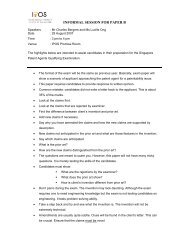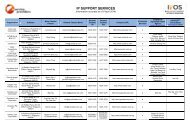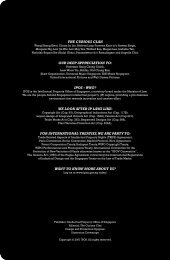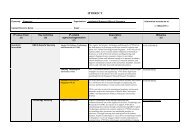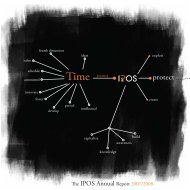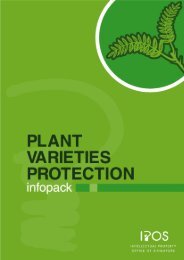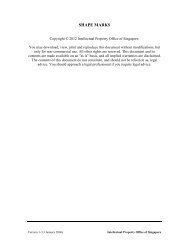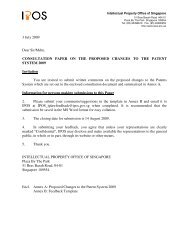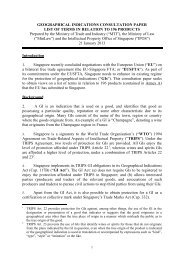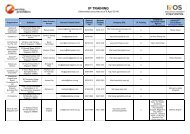Here - Intellectual Property Office of Singapore
Here - Intellectual Property Office of Singapore
Here - Intellectual Property Office of Singapore
Create successful ePaper yourself
Turn your PDF publications into a flip-book with our unique Google optimized e-Paper software.
1 - INTRODUCTION AND FUNDAMENTALS<br />
Classification <strong>of</strong> Goods and Services<br />
The scope <strong>of</strong> a trade mark registration is determined by the goods or services in relation to which the trade<br />
mark is registered. For the purpose <strong>of</strong> trade mark registration, <strong>Singapore</strong> uses the International<br />
Classification <strong>of</strong> Goods and Services as prescribed by the Nice Agreement to classify trade mark<br />
registrations. The Nice Agreement is an international agreement on classification <strong>of</strong> goods and services to<br />
which <strong>Singapore</strong> is a party. This classification sets out the list <strong>of</strong> goods and services for which the<br />
applicant may wish to register for in relation to his trade mark. The list groups these goods and services into<br />
classes in which these goods and services belong. There are a total <strong>of</strong> 34 classes <strong>of</strong> goods and 11<br />
classes <strong>of</strong> services (page 17).<br />
>> The Nice Classification is a tool for the classification <strong>of</strong> goods and services for the purposes <strong>of</strong> the registration <strong>of</strong><br />
marks. It is used in more than 140 countries worldwide and in international applications for the registration <strong>of</strong><br />
marks under the Madrid Agreement and Protocol.<br />
Trade Mark Information Search<br />
Before registering a trade mark, it is advisable to first conduct a search <strong>of</strong> the existing trade marks to<br />
ensure its registrability. There are resources available to help search for existing trade marks.<br />
accessible via the IPOS website www.ipos.gov.sg, is a one-stop website to facilitate online trade mark<br />
searches and online filing <strong>of</strong> trade mark applications and related transactions in <strong>Singapore</strong>.<br />
The eTradeMarks<br />
Search Terminals<br />
available at IPOS’ Public Search Area allow the public to access<br />
IPOS’ records <strong>of</strong> trade mark applications and trade marks<br />
registered in <strong>Singapore</strong>. The relevant usage and printing fees will<br />
apply.<br />
Note: These tools and resources provide non-exhaustive searches. Applicants are advised to check the<br />
databases <strong>of</strong> other countries for trade marks registered in the respective countries.<br />
Identifying a Registered Trade Mark<br />
® and are common symbols associated with trade marks. ® indicates that the mark is a registered<br />
trade mark and hence protected under the trade mark law. is just a symbol used to indicate that the<br />
mark is used by the company as a trade mark. It does not denote that the mark is registered nor<br />
protected under the trade mark law.<br />
Not Registering a Trade Mark<br />
It is not compulsory to register a trade mark in <strong>Singapore</strong>. An individual, firm or company, who owns a<br />
trade mark and uses it in connection with his goods or services, acquires common law rights in that mark<br />
by virtue <strong>of</strong> the use and reputation <strong>of</strong> the mark.<br />
>> Common law generally refers to the law based on past decisions and general principles, serving as<br />
precedent or is applied to situations not covered by statutes.<br />
For a mark that is not registered, the owner can only rely on the common law action <strong>of</strong> “passing <strong>of</strong>f” to<br />
protect his mark against imitation or infringement. This remedy, however, requires the owner <strong>of</strong> the mark<br />
to prove his reputation and goodwill. The requirement <strong>of</strong> proving reputation and goodwill may pose some<br />
problems where the business, or the use <strong>of</strong> the trade mark, has not been established for a substantial<br />
period <strong>of</strong> time.<br />
A registered trade mark, on the other hand, grants the owner <strong>of</strong> the trade mark a statutory monopoly. If<br />
someone else uses the same or a similar mark on the same or similar goods or services in respect <strong>of</strong><br />
which the mark is registered, the registered trade mark owner can rely on his registration as pro<strong>of</strong> <strong>of</strong> his<br />
right to the mark and sue for infringement.<br />
4



